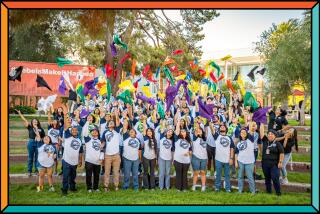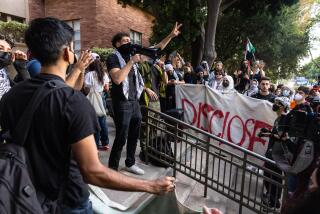Thousands honor ’68 walkouts by Mexican American students
As she joined about 2,500 marchers striding through neighborhoods east of downtown Los Angeles on Saturday with placards that read, “Brown and Proud: I’m the next generation,” 17-year-old Santa Monica High School senior Jennifer Galamba said, “We’re here to honor heroes and a defining moment in our history.”
Galamba was among those who turned out for a 40th anniversary celebration of the student walkouts and marches at five high schools -- Roosevelt, Garfield, Wilson, Belmont and Lincoln -- that helped ignite a powerful new force on the American political scene: the Chicano Movement.
The event featured a 1.5-mile march from Lincoln High School to Boyle Heights’ Hazard Park that included hundreds of youths and dozens of the original student activists whose actions unfolded into the first act of mass militancy by Mexican Americans in Southern California.
Later this year at the park, a granite boulder with a plaque is to be dedicated to the courage and legacy of the students now known as “Los Ninos Heroes.”
In March 1968, hundreds of high school students walked out of the predominantly Mexican American high schools, demanding better teachers, smaller classes and equal opportunity in higher education. They did not know they were launching a civil rights crusade that would affect generations to come.
Within days, close to 22,000 students, some flanked by Brown Beret bodyguards, were participating in walkouts, speeches, picketing, clashes with police and emergency school board sessions.
Margarita Cuaron was a 15-year-old junior at Garfield High when she strode out of English class, picked up a bullhorn, climbed on top of a car and began shouting, “Walkout! Walkout! Walkout!”
A few days later, she was arrested in the principal’s office on misdemeanor charges of disturbing the peace, then suspended for a month. When Cuaron returned to school, her history teacher chastised her in class. “You should be ashamed of yourself,” said the teacher, who flunked her.
The events “left an indelible mark on me,” said Cuaron, 55, now a registered nurse with the Highland Park office of the L.A. County Department of Mental Health. “It was like living in the eye of a torrential and profound storm.”
The man of the hour Saturday was Sal Castro, a former social studies and government teacher at Lincoln High who walked out of class with his students.
Before that, students said they wanted to express their frustrations by holding a “blowout,” or walkout, Castro recalled. His response: “Organize. What do you need?”
A walkout committee was established at four of the schools. With help from college students, the high schoolers made signs and printed demands.
The original plan was to present their concerns -- and the threat of a walkout -- to the Board of Education.
But on March 1, the principal at Wilson abruptly canceled performances of the high school play, “Barefoot in the Park,” saying it was unfit. That was the last straw.
“Fearful that the cops would come down on us, I told the college kids, ‘I need you for your heads,’ ” Castro recalled. “They thought I meant brain power. But I said, ‘I literally need your heads in the way in case cops start swinging batons on students.’ ”
College recruits included Carlos Munoz Jr., who was among 13 people arrested and indicted on misdemeanor charges by a grand jury for conspiracy to disturb the peace. All were later exonerated, said Munoz, 68, now professor emeritus at UC Berkeley and author of books including “Youth, Identity, Power: The Chicano Movement.”
“At the moment we were in the midst of making history, we weren’t aware of it,” Munoz said. “We were acting on raw feelings. I had gone through the public school system in Los Angeles at a time when Mexican American students were automatically labeled wood shop majors.”
“I was an honors student and president of the student body at Belmont High and thinking I was all set for a university,” he said. “Yet I had not been given any science or algebra courses, so I ended up having to first go to a community college.”
A year after the walkouts, UCLA’s enrollment of Mexican American students soared from 100 to 1,900. Over the following decade, college enrollment increased from 2% to 25% nationwide.
Many walkout participants went on to successful careers in politics, academia and the arts.
Paula Cristostomo is director of government and community relations at Occidental College. Ray Santana is an attorney in the San Gabriel Valley. Cassandra J. Zacarias is a high school teacher in Santa Fe Springs.
Then there is Bobby Verdugo, 57, a social worker who works with teenage fathers.
As marchers gathered Saturday on North Broadway with flags of both the United States and Mexico, he recalled, “Man, we were scared to walk out of class because of the possible consequences. If anyone tells you they weren’t scared, they are either lying or forgot a lot.”
“But we were fed up, you know?” he said. “A year earlier, a teacher had said to me, ‘Verdugo, you have three strikes against you: You’re an underachiever, you’re lazy and you’re Mexican.’ ”
“Well look at me now,” he said with a smile. “I’m a social worker who lectures across the nation, and today I’m marching with thousands.”
--
More to Read
Sign up for Essential California
The most important California stories and recommendations in your inbox every morning.
You may occasionally receive promotional content from the Los Angeles Times.











